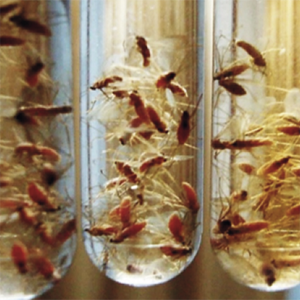A progressive change in the virulence spectrum of Asian rice gall midge (Orseolia oryzae) biotype 2 after a decade in Coastal Karnataka, India

Accepted: 17 November 2022
HTML: 205
All claims expressed in this article are solely those of the authors and do not necessarily represent those of their affiliated organizations, or those of the publisher, the editors and the reviewers. Any product that may be evaluated in this article or claim that may be made by its manufacturer is not guaranteed or endorsed by the publisher.
Authors
Virulence composition of traditionally designated biotype 2 field population of Asian rice gall midge, Orseolia oryzae (Wood- Mason) (Cecidomyiidae: Diptera) was conducted a decade after in 2019 and 2020 at coastal Karnataka, India using three standard differentials viz., W1263 (Gm1 gene for resistance), Phalguna (Gm2 gene for resistance) and TN1 (susceptible without any gene). The local population of gall midge was virulent against all 16 standard rice gene differentials representing four groups identified to characterize the prevailing rice gall midge biotypes in India. The local gall midge populations in the test locations expressed their virulence against all three rice gene differentials with varied female to male sex ratio of their F1 progenies. This confirms the prevalence of genetically heterogeneous population in coastal regions of Karnataka. Clearly, a progressive change in the virulence spectrum of local gall midge biotype 2 was noticed a decade after observations. In south coast, 73.33 to 87.27% population showed virulent attributes of traditional biotype 2 designated in 1989. Whereas in north coast, 79.69 to 86.36% population exhibited virulence attributes towards new biotype 3 for the first time in the state of Karnataka, India. These results suggested a progressive change in the traditionally designated population of biotype 2 capable of damaging resistant varieties in the region for over three decades. Further, the single female test for their F1 progenies in all endemic locations indicated an evolution of new biotype of rice gall midge in the region.
Supporting Agencies
Science and Engineering Research Board (SERB), Department of Science and Technology, Ministry of Science and Technology, Government of India under the Grant No. EEQ/2017/000484/26/3/2018.How to Cite

This work is licensed under a Creative Commons Attribution-NonCommercial 4.0 International License.
PAGEPress has chosen to apply the Creative Commons Attribution NonCommercial 4.0 International License (CC BY-NC 4.0) to all manuscripts to be published.

 https://doi.org/10.4081/jear.2022.10764
https://doi.org/10.4081/jear.2022.10764



